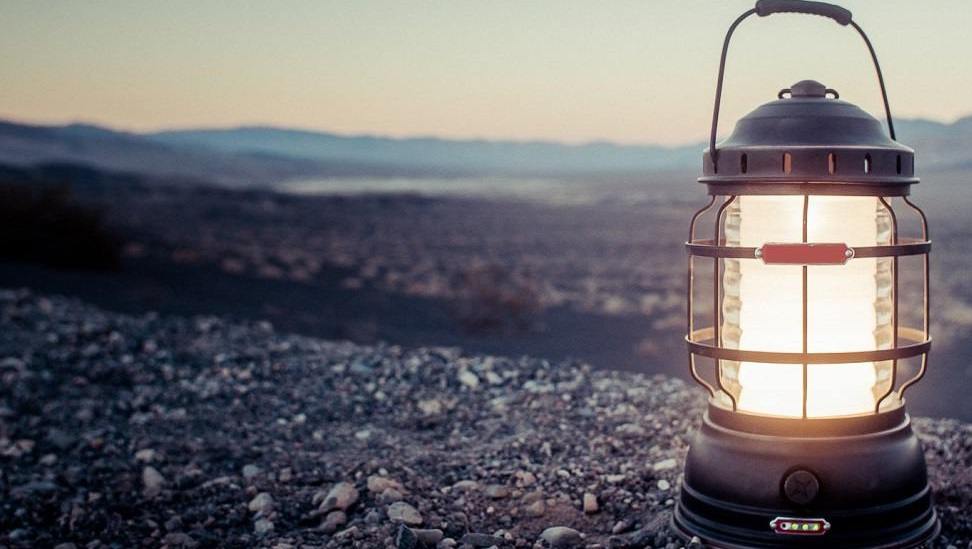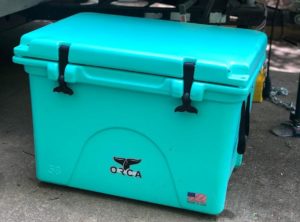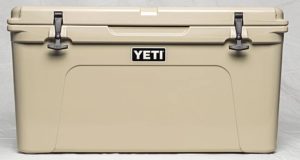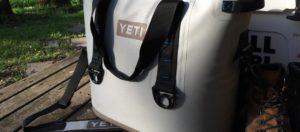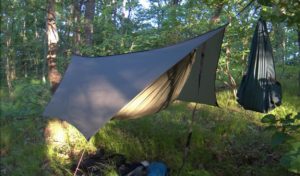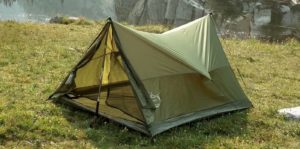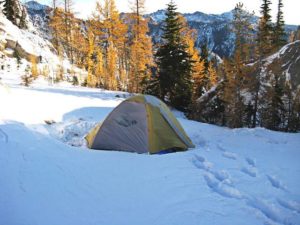Which camping lantern best lights your family adventures? Or helps in a power outage and around the house? To find out, we researched the 25 most sold models. We took months of well-lit adventures up and down the West Coast while camping & backpacking. To help you find the perfect one, we analyzed the performance in five critical categories. We evaluated them for outdoor adventure camping, RVing, and emergency backup lighting at home. With this in mind, our choices reflect the best all-around, the best value and the best lightweight backcountry option.
Best Lantern for Camping: Black Diamond Apollo
- Legs feature rubber tips
- Ability to dim
- Dual metal hanging hooks
- Cool innovative design
- Easy to use & durable
With an innovative design and reliable performance, the Apollo rose to the top. It’s versatility instantly made it our go-to on camping trips and during power outages. Though not the lightest or brightest, it makes an excellent multipurpose option without sacrificing quality. Our favorite use was camping, but it’s also ideal for larger backpacking groups or as a base camp light. Also, Black Diamond offers an eco-friendly and money saving Black Diamond NRG Rechargeable Battery Kit and Black Diamond NRG / NRG2 Car Charger Kit that recharges the battery similar to a cell phone charger. If you are looking for a product that excels in every category, we highly recommend the Apollo.
Best Eco-Friendly: MPOWERD Luci Original
- Needs no batteries – runs on solar
- Fun
- Inflatable, waterproof, & floats!
- Lightweight
- Ease of operation
The Luci Original is the lightest product that we tested and it’s solar powered. It only costs $15, and we took it camping, backpacking and just used it around the house. Several Lucis together make great backyard party decorations. It takes a full eight hours to charge but the charge lasts about 12 hours on high. This light packs down to a think disk when deflated. The Luci is also waterproof and floats.
Best for Backcountry: Black Diamond Voyager
- Versatility
- Brightness
- Light modes are adjustable
- Easy to hang
- Can be used as both a flashlight and a lantern
The Voyager is light and extremely compact. As the little brother to the Apollo, we found ourselves reaching for the Orbit almost as much as the Editors’ Choice winner. The Voyager also conveniently offers the Black Diamond NRG2 Rechargeable Battery Kit sold separately. We loved the flashlight feature on this product and the fact that it is small and lightweight. Before embarking on this review, we had never backpacked with lanterns, preferring headlamps for our evening activities. Though we still bring headlamps, this review demonstrated the beauty of collecting around a central light source, particularly in areas where fires are prohibited. Of all the products we tested, the Voyager is the only one we would take into the backcountry.
Best for Durability: Streamlight The Siege
- Durability
- Feature-packed
- Water resistant & floats
- Light output isn’t full adjustable
- Small
If you want to punish your camping lights, get The Siege. It’s waterproof, floats, and just generally takes a beating. It’s constructed with polycarbonate thermoplastic and has a rubberized base, bottom and top. It has three LEDs; one white and two red. The outer globe is removable so you can hang it upside down for lighting larger areas. It’s also magnetic.
Choosing the Best Lantern for Your Needs
Why buy a lantern instead of just a headlamp? Lanterns provide a 360-degree central lighting source. This allows people to share one source of light, whereas a headlamp is for personal spotlighting. A lantern illuminates a campsite and provides important illumination during emergencies and power outages. Bringing one for the group can eliminate the need for everyone to have a headlamp.
Battery and solar powered contenders on the left and fuel powered products tested on the right.

Types of Lanterns
There are three main uses: emergencies, camping, and backcountry. Emergency and camping are similar in that weight is less important and the lumen output is more critical. For an emergency, battery life and ease of use is essential as well. Backpacking models should be light, compact, and durable enough to withstand the elements.
We tested eight contenders, ranging from ultralight ones that fit in the palm of your hand, hefty, bright models bigger than your head and even a solar model. Not all of them were directly comparable, but considering the large variety, we have recommended those based on their intended use.
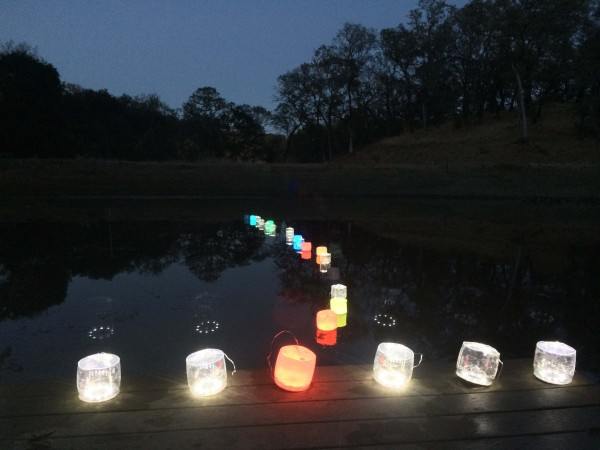
For more of our camping gear recommendations, check these guides:
How We Chose
Brightness
We found brightness to be one of the most important factors. A huge factor for us was whether or not it was uncomfortably bright. If it was blinding we were much less likely to place it in the middle of camp at dinner, or read by it in our tent. We loved having the ability to control the brightness, which allowed us to adjust the light based on the setting and number of people present.
The other factor that affects the light quality is how light projects. No one wants to stare directly at a light bulb. This is where the globe, the “lampshade” of lanterns, comes in. The Coleman Northstar was the brightest we tested. However, its globe is nothing but clear glass; looking at the light directly can be uncomfortable.
Coleman Northstar on the left and the UST 30 Day Duro Glow on the right.
Ease of Use
How easy is it to hang the lantern? That’s one of the most important factors we analyzed.
Size also contributes to how easy it is to use. For example, a large heavy model like the Coleman Northstar can be tough to use in a smaller tent or at your bedside table due to its large footprint and weight. A small model is easier to use and more useful in a tent than out in the open trying to illuminate your cooking area. We rated them based on their intended use.
Clockwise from the left: Northstar, Apollo, The Siege, and the EasyLight. The two on the left take fuel to run, the two on the right need batteries and are more suited for use inside a tent.
Sturdiness
What good is it if it doesn’t last? The durability of the construction of the lanterns in many different environments. The products tested were made of plastic, but they were made sturdier by added metal and rubber worked into the design.
Two of the products we tested are waterproof: The Siege and the MPOWERD Luci light. They also both float.
Another important factor is battery life. The MPOWERD Luci Original is a solar powered product that doesn’t require batteries at all but did take a full eight hours to charge. The Goal Zero Lighthouse 250 doesn’t need any batteries as well and charges via a USB cord but it doesn’t hold a charge for very long on the highest setting.
Extra Features
We would score such a design such rather low in the features category. We checked if the features of each one improved the quality of the lantern.
Another thing to note is that a product with many useful features tended to be easier to use. We especially liked the products with dimmable power outputs like the brilliant Coleman Northstar, both Black Diamond products, the Primus EasyLight and the Goal Zero Lighthouse.
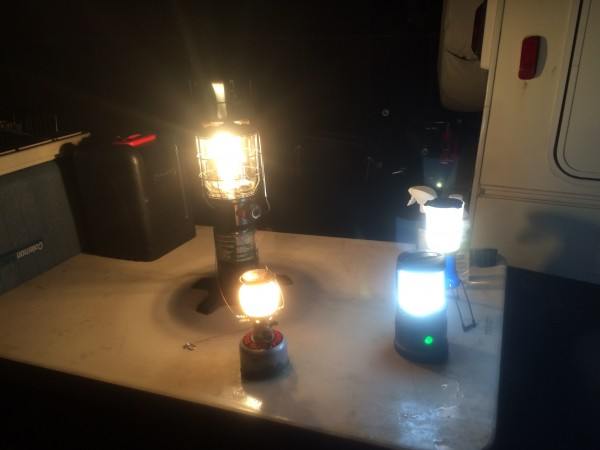
Weight
The Northstar is the heaviest contender tested at about 4.5 lbs and is one of the two products we tested that use mantles and fuel. The next heaviest product we tested was The Siege. The Siege and the 30 Day Duro were about the same weight and both require D batteries. The Siege weighs 1 lb 15 oz and the Duro 1 lb 13 oz. The Lighthouse weighs 1.1 lbs and requires no batteries at all, just a USB charge. The BD Apollo is next in line at .71 lbs. Both BD models we tested take AA batteries. The EasyLight weighs .41 lbs but keep in mind that is without a fuel canister attached. The BD Voyager weighs a mere .35 lbs and is small enough to fit into your pocket. The lightest product we tested is the solar-powered inflatable Luci light which weighs a mere .28 lbs.
Conclusion
While conducting this review, we were surprised how many times we found the products in this category to be so useful, and in many cases, more convenient that our beloved headlamps. If you’re in the market to purchase a stand-alone lamp for the outdoors, it can be tough to choose the best product. For one, we don’t know any stores that allow you to take their products out overnight to test them out. Luckily, you now have this review to be your guide and reference as you search for the model that suits you best.
Matt Baker

